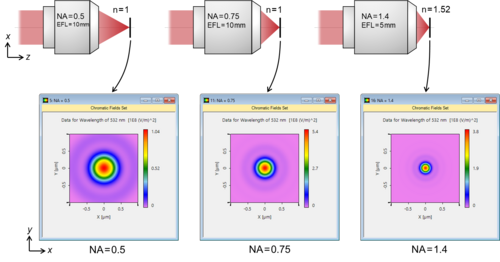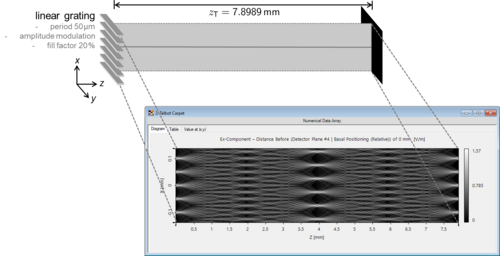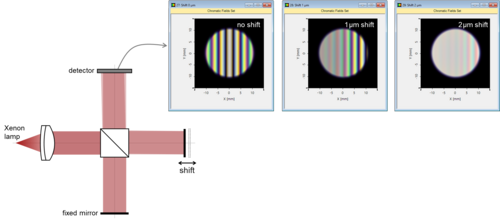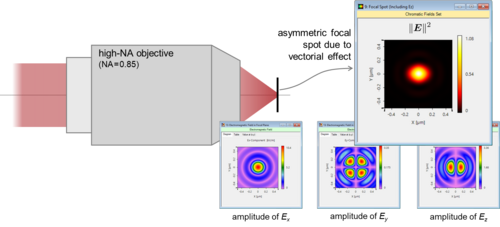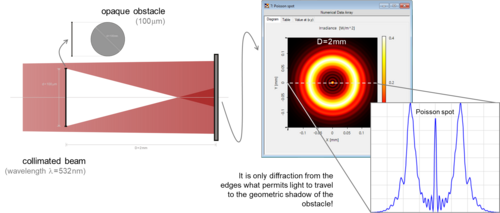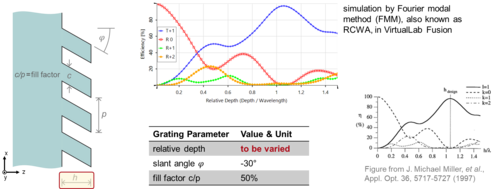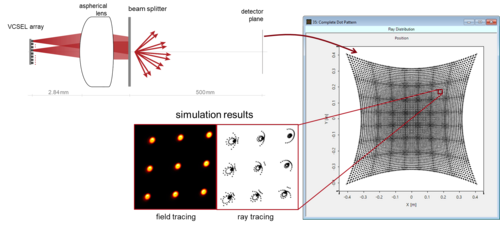What’s new in our Optical Modeling and Design Software?
Rayleigh Criterion
The Rayleigh criterion is often used in practice to characterize the resolution limit of microscope or telescope systems. It is defined as follows: when the center of the diffraction pattern of one point is just overlapped with the first minimum of the diffraction pattern of another point, according to the Rayleigh criterion they can just be resolved. With VirtualLab Fusion, we investigate three real objective lenses with different values of the NA (numerical aperture) following Rayleigh’s theory, and also compare the lens performance with the ideal case predicted by the Debye-Wolf integral.
Read moreTalbot Effect
The Talbot effect, one of the best-known diffraction effects in relation to gratings, was first observed in 1836 by Henry Fox Talbot. When a periodic structure, e.g. a grating, is illuminated by a plane wave, one can observe the image of the grating at a certain distance (or its multiple) behind the grating. This specific distance is called the Talbot length. Thanks to the automatized free-space propagation technology in VirtualLab Fusion, such effects can be easily and accurately reproduced and analyzed. We demonstrate it with both linear and crossed gratings as examples.
Read moreBeyond Ray Tracing - Germany & Japan
Darmstadt | Germany – 20 November
Tokyo | Japan – 4 December
Due to high demand, we are happy to announce that we
have scheduled two more seminars for this year.
Meet our experts and learn how to use VirtualLab Fusion
for the optical design tasks in your field of application.
Register for the seminars and indicate your areas of interest.
This information will be used to shape the content of the session.
Michelson Interferometer and Optical Metrology
Since the famous Michelson-Morley experiment in 1887, the Michelson interferometer and its variations have continued to play an important role in optical research. Nowadays, one can still often find optical systems configured in the form of a Michelson interferometer, for example, in coherent scanning interferometry. With VirtualLab Fusion, especially with the help of non-sequential field tracing, we show the working principle of a white-light Michelson interferometer, and demonstrate how it can be applied for optical metrology.
Read moreAnalysis of High-NA Lenses
High-NA (numerical aperture) lenses are typically used in optical microscopy or lithography, among other applications. It is known that the impact of the vectorial nature of electromagnetic fields is not negligible in such situations. A well-known effect that exemplifies the above is the asymmetry exhibited by the focal spot generated by a high-NA lens focusing a linearly polarized circular beam: the focal spot ceases to be circular and appears elongated. We show these effects for specific examples of objective lenses and demonstrate how to analyse focal spots using different detectors in VirtualLab Fusion.
Read morePoisson Spot Simulation & Double-Slit Modeling
The first-time observation of Poisson’s (or Arago’s) spot in 1818 constituted one of the most relevant experiments in the history of optics, helping discard the (at the time) favored position of attributing a corpuscular nature to light. When Fresnel presented his theory of diffraction before the French Academy of Sciences, Poisson, a member of the committee, scoffed at the fact that Fresnel’s approach predicted a bright spot in the shadow of a circular obstacle placed in the way of a beam of light. Here, we demonstrate this effect in VirtualLab Fusion, and, with the help of programmable functions, also the diffraction effects caused by different obstacles can be studied. For the latter case, we present an example of the modeling of a double-slit via a functional embodiment.
Read moreSlanted Gratings
Slanted gratings have been found to be of advantage in lightguide-based display systems for AR/MR applications. Such gratings often have periods that are comparable to the wavelength. Therefore, rigorous computational methods must be used to evaluate their performance. We show, in accordance with existing examples from literature, how to model slanted gratings with different geometries using the Fourier modal method (FMM) in VirtualLab Fusion. Additionally, customized slanted gratings can be designed with the help of parametric optimization.
Read moreLarge-Angle Dot Projector
A large-angle dot projector is the key optical component in Apple’s Face ID, which casts a structured dot pattern onto the face so as to create a 3D facial map. The dot projection system often employs an array of VCSEL units. Light from the VCSEL array is first collimated by a lens system, and then replicated by a two-dimensional grating into a large angular range. Simulation of such systems would require an appropriate model of the VCSEL source, a dependable handling of the lens system, and a rigorous method for gratings with relatively small periods. In VirtualLab Fusion, this connection of different field solvers is par for the course; we use this ability below in a demonstration of how a dot projector works.
Read more



